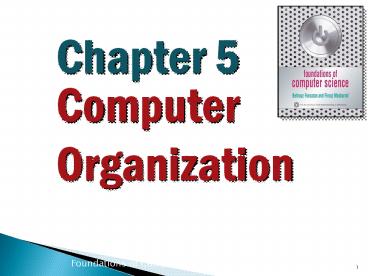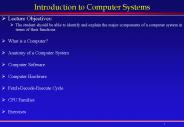Computer - PowerPoint PPT Presentation
Title: Computer
1
Chapter 5
Computer Organization
Foundations of Computer Science ã Cengage Learning
2
Objectives
After studying this chapter, the student should
be able to
- List the three subsystems of a computer.
- Describe the role of the central processing unit
(CPU). - Describe the fetch-decode-execute phases of a
cycle. - Describe the main memory and its addressing
space. - Define the input/output subsystem.
- Understand the interconnection of subsystems.
- Describe different methods of input/output
addressing.
3
We can divide the parts that make up a computer
into three broad categories or subsystem the
central processing unit (CPU), the main memory
and the input/output subsystem.
Figure 5.1 Computer hardware (subsystems)
4
5-1 CENTRAL PROCESSING UNIT
The central processing unit (CPU) performs
operations on data. In most architectures it has
three parts an arithmetic logic unit (ALU), a
control unit and a set of registers, fast storage
locations.
5
The arithmetic logic unit (ALU)
The central processing unit (CPU) performs
operations on data. In most architectures it has
three parts an arithmetic logic unit (ALU), a
control unit and a set of registers, fast storage
locations (Figure 5.2).
Figure 5.2 Central processing unit (CPU)
6
Registers
Registers are fast stand-alone storage locations
that hold data temporarily. Multiple registers
are needed to facilitate the operation of the
CPU. Some of these registers are shown in Figure
5.2.
- Data registers
- Instruction register
- Program counter
7
The control unit
The third part of any CPU is the control unit.
The control unit controls the operation of each
subsystem. Controlling is achieved through
signals sent from the control unit to other
subsystems.
8
5-2 MAIN MEMORY
Main memory is the second major subsystem in a
computer (Figure 5.3). It consists of a
collection of storage locations, each with a
unique identifier, called an address. Data is
transferred to and from memory in groups of bits
called words. A word can be a group of 8 bits, 16
bits, 32 bits or 64 bits (and growing). If the
word is 8 bits, it is referred to as a byte. The
term byte is so common in computer science that
sometimes a 16-bit word is referred to as a
2-byte word, or a 32-bit word is referred to as a
4-byte word.
9
Figure 5.3 Main memory
10
Address space
To access a word in memory requires an
identifier. Although programmers use a name to
identify a word (or a collection of words), at
the hardware level each word is identified by an
address. The total number of uniquely
identifiable locations in memory is called the
address space. For example, a memory with 64
kilobytes and a word size of 1 byte has an
address space that ranges from 0 to 65,535.
11
Memory addresses are defined using
unsignedbinary integers.
12
Example 5.1
A computer has 32 MB (megabytes) of memory. How
many bits are needed to address any single byte
in memory?
Solution The memory address space is 32 MB, or
225 (25 220). This means that we need log2 225,
or 25 bits, to address each byte.
Example 5.2
A computer has 128 MB of memory. Each word in
this computer is eight bytes. How many bits are
needed to address any single word in memory?
Solution The memory address space is 128 MB,
which means 227. However, each word is eight (23)
bytes, which means that we have 224 words. This
means that we need log2 224, or 24 bits, to
address each word.
13
Memory types
Two main types of memory exist RAM and ROM.
Random access memory (RAM)
- Static RAM (SRAM)
- Dynamic RAM (DRAM)
Read-only memory (ROM)
- Programmable read-only memory (PROM).
- Erasable programmable read-only memory (EPROM).
- Electrically erasable programmable read-only
memory (EEPROM).
14
Memory hierarchy
Computer users need a lot of memory, especially
memory that is very fast and inexpensive. This
demand is not always possible to satisfyvery
fast memory is usually not cheap. A compromise
needs to be made. The solution is hierarchical
levels of memory.
Figure 5.4 Memory hierarchy
15
Cache memory
Cache memory is faster than main memory, but
slower than the CPU and its registers. Cache
memory, which is normally small in size, is
placed between the CPU and main memory (Figure
5.5).
Figure 5.5 Cache memory
16
5-3 INPUT/OUTPUT SUBSYSTEM
The third major subsystem in a computer is the
collection of devices referred to as the
input/output (I/O) subsystem. This subsystem
allows a computer to communicate with the outside
world and to store programs and data even when
the power is off. Input/output devices can be
divided into two broad categories non-storage
and storage devices.
17
Non-storage devices
Non-storage devices allow the CPU/memory to
communicate with the outside world, but they
cannot store information.
- Keyboard and monitor
- Printer
18
Storage devices
Storage devices, although classified as I/O
devices, can store large amounts of information
to be retrieved at a later time. They are cheaper
than main memory, and their contents are
nonvolatilethat is, not erased when the power is
turned off. They are sometimes referred to as
auxiliary storage devices. We can categorize them
as either magnetic or optical.
19
Figure 5.6 A magnetic disk
20
Figure 5.7 A magnetic tape
21
Different between Magnetic disk and Magnetic
tape
Magnetic disk Magnetic tape
Surface organization See figure 5.6 See figure 5.7
Data Access Random access device Sequential access device
Performance Depend on three factors 1- rotational speed 2-seek time 3-transfer time Slower and cheaper
22
Optical storage device
1- CD-ROMs a. CD-R b. CD-RW 2-DVD
23
5-4 SUBSYSTEM INTERCONNECTION
The previous sections outlined the
characteristics of the three subsystems (CPU,
main memory, and I/O) in a stand-alone computer.
In this section, we explore how these three
subsystems are interconnected. The
interconnection plays an important role because
information needs to be exchanged between the
three subsystems.
24
Connecting CPU and memory
The CPU and memory are normally connected by
three groups of connections, each called a bus
data bus, address bus and control bus (Figure
5.12).
Figure 5.12 Connecting CPU and memory using
three buses
25
Connecting I/O devices
I/O devices cannot be connected directly to the
buses that connect the CPU and memory, because
the nature of I/O devices is different from the
nature of CPU and memory. I/O devices are
electromechanical, magnetic, or optical devices,
whereas the CPU and memory are electronic
devices. I/O devices also operate at a much
slower speed than the CPU/memory. There is a need
for some sort of intermediary to handle this
difference. Input/output devices are therefore
attached to the buses through input/output
controllers or interfaces. There is one specific
controller for each input/output device (Figure
5.13).
26
Figure 5.13 Connecting I/O devices to the buses
27
Figure 5.14 SCSI controller
28
Figure 5.15 FireWire controller
29
Figure 5.16 USB controller
30
Addressing input/output devices
The CPU usually uses the same bus to read data
from or write data to main memory and I/O device.
The only difference is the instruction. If the
instruction refers to a word in main memory, data
transfer is between main memory and the CPU. If
the instruction identifies an I/O device, data
transfer is between the I/O device and the CPU.
There are two methods for handling the addressing
of I/O devices isolated I/O and memory-mapped
I/O.
31
5-5 PROGRAM EXECUTION
Today, general-purpose computers use a set of
instructions called a program to process data. A
computer executes the program to create output
data from input data. Both the program and the
data are stored in memory.
At the end of this chapter we give some examples
of how a hypothetical simple computer executes a
program.
32
Machine cycle
The CPU uses repeating machine cycles to execute
instructions in the program, one by one, from
beginning to end. A simplified cycle can consist
of three phases fetch, decode and execute
(Figure 5.19).
Figure 5.19 The steps of a cycle
33
Input/output operation
Commands are required to transfer data from I/O
devices to the CPU and memory. Because I/O
devices operate at much slower speeds than the
CPU, the operation of the CPU must be somehow
synchronized with the I/O devices. Three methods
have been devised for this synchronization
programmed I/O, interrupt driven I/O, and direct
memory access (DMA).
- Programmed I/O
- Interrupt driven I/O
- Direct memory access (DMA
34
Figure 5.20 Programmed I/O
35
Figure 5.21 Interrupt-driven I/O
36
Figure 5.22 DMA connection to the general bus
37
Figure 5.23 DMA input/output































